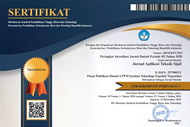Framework Assessment of Sustainable Roads Infrastructure In Indonesia
Abstract
Keywords
Full Text:
PDFReferences
K. PUPR, “Dukungan Masif Infrastruktur PUPR Untuk Lima Destinasi Pariwisata Super Prioritas,” 2019.
L. Kiziridis, “An effective evaluation framework with a reporting method”.
O. Taylan, R. Alamoudi, M. Kabli, A. Aljifri, F. Ramzi, and E. Herrera-Viedma, “Assessment of energy systems using extended fuzzy AHP, fuzzy VIKOR, and TOPSIS approaches to manage non-cooperative opinions,” Sustain., vol. 12, no. 7, 2020, doi: 10.3390/su12072745.
F. Censorii, L. Cotignoli, V. Vignali, and A. Bartoli, “ENVISION - Italy Adapted - Sustainable and Resistant Road Infrastructures,” 2022, [Online]. Available: https://doi.org/10.3390/coatings12020236
S. O. Ametepey, C. O. Aigbavboa, and W. D. Thwala, “A Conceptual Framework for Sustainable Road Infrastructure Project Implementation in Developing Countries,” vol. 2021, no. July 2020, pp. 610–618, 2019, doi: 10.3311/ccc2019-084.
K. J. Faah, “Analisis kesiapan daerah dalam penerapan konsep jalan berkelanjutan (Green Road) di Kota Kupang,” 2017, [Online]. Available: https://repository.unpar.ac.id/handle/123456789/5444
C. S. Goh and S. Rowlinson, “Conceptual Maturity Model for Sustainable Construction,” J. Leg. Aff. Disput. Resolut. Eng. Constr., vol. 5, no. 4, pp. 191–195, 2013, doi: 10.1061/(asce)la.1943-4170.0000129.
A. Karji and A. Karji, “DigitalCommons @ University of Nebraska - Lincoln Social Sustainability Indicators in Mass Housing Construction Social Sustainability Indicators in Mass Housing Construction,” 2017.
M. Christian Lallo, Ir. R. J. Poluan, Msi, Dr. Judy O. Waani, ST., “No Title كتاب المجامع,” مجلة العربية, vol. 2, no. 5, p. 255, 2009, [Online]. Available: ???
J. M. Diaz-sarachaga, “Sustainable Development Goals in Green Infrastructure Rating Systems,” no. November, pp. 1–10, 2016, [Online]. Available: https://www.researchgate.net/publication/310845298_Sustainable_Development_Goals_in_Green_Infrastructure_Rating_Systems
F. Corriere and A. Rizzo, “Sustainability in Road Design: A Methodological Proposal for the Drafting of Guideline,” Procedia - Soc. Behav. Sci., vol. 53, pp. 39–48, 2012, doi: 10.1016/j.sbspro.2012.09.858.
A. Amiril, A. H. Nawawi, R. Takim, and S. N. F. A. Latif, “Transportation Infrastructure Project Sustainability Factors and Performance,” Procedia - Soc. Behav. Sci., vol. 153, pp. 90–98, 2014, doi: 10.1016/j.sbspro.2014.10.044.
S. I. Sarsam, “Sustainable and Green Roadway Rating System,” Int. J. Sci. Res. Environ. Sci., vol. 3, no. 3, pp. 99–106, 2015, doi: 10.12983/ijsres-2015-p0099-0106.
M. A. Rohman, H. Doloi, and C. A. Heywood, “Success criteria of toll road projects from a community societal perspective,” Built Environ. Proj. Asset Manag., vol. 7, no. 1, pp. 32–44, 2017, doi: 10.1108/BEPAM-12-2015-0073.
F. R. Rivai, M. A. Rohman, and Supani, “A framework for mapping stakeholders interests related social sustainability in residential building,” IOP Conf. Ser. Mater. Sci. Eng., vol. 930, no. 1, 2020, doi: 10.1088/1757-899X/930/1/012003.
W. Li, W. Liang, L. Zhang, and Q. Tang, “Performance assessment system of health, safety and environment based on experts’ weights and fuzzy comprehensive evaluation,” J. Loss Prev. Process Ind., vol. 35, pp. 95–103, 2015, doi: 10.1016/j.jlp.2015.04.007.
T. L. Saaty, “How to make a decision,” Int. Ser. Oper. Res. Manag. Sci., vol. 175, pp. 1–21, 2012, doi: 10.1007/978-1-4614-3597-6_1.
D. Aullya Rachmawati, “Analisis Framework Sistem Pendukung Keputusan Penilaian Kinerja Karyawan Pada Pt. Xyz,” Anal. Framew. Sist. Pendukung Keputusan Penilai. Kinerja Karyawan Pada Pt. Xyz, pp. 6–8, 2015.
K. Kabassi, C. Karydis, and A. Botonis, “AHP, fuzzy SAW, and fuzzy WPM for the evaluation of cultural websites,” Multimodal Technol. Interact., vol. 4, no. 1, 2020, doi: 10.3390/mti4010005.
DOI: http://dx.doi.org/10.12962%2Fj2579-891X.v22i3.20070
Refbacks
- There are currently no refbacks.

Jurnal Aplikasi Teknik Sipil by Pusat Publikasi Ilmiah LPPM Institut Teknologi Sepuluh Nopember is licensed under a Creative Commons Attribution-ShareAlike 4.0 International License
Based on work at https://iptek.its.ac.id/index.php/jats




